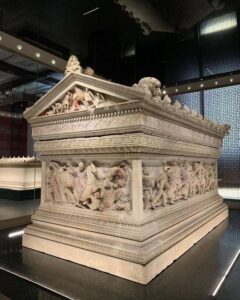1. Introduction to the “Alexander Sarcophagus”
The “Alexander Sarcophagus” is one of the most renowned and captivating artifacts from the Hellenistic period, now housed at the Istanbul Archaeology Museum. Although it is not the actual resting place of Alexander the Great, this title was given due to its intricate reliefs depicting battles between Alexander and the Persian Empire, showcasing his military talent and bravery. However, many historians believe that this sarcophagus may actually belong to Abdalonymos, a king of Sidon appointed by Alexander in the 4th century BCE.
2. Discovery History and Cultural Background
2.1. Excavations at Sidon
In 1887, the sarcophagus was discovered during the excavation of the Royal Necropolis in Sidon, present-day Lebanon, a region once central to Phoenician culture. The excavation was led by the famous Ottoman archaeologist Osman Hamdi Bey, who went to great efforts to have this artifact brought back and preserved within the Ottoman Empire.
2.2. Cultural and Historical Background
At this time, Sidon was an important city under Alexander’s control following his Persian campaigns. After defeating the Persian Empire, Alexander appointed Abdalonymos as king of Sidon. The sarcophagus may have been crafted specifically in his honor, symbolizing the cultural blending of Greek and Phoenician styles of the era.

3. Architecture and Sculpture: Highlights of the “Alexander Sarcophagus”
3.1. Battle Scene Reliefs
One of the sarcophagus’s standout features is the intricate depiction of battle scenes. These carvings show Alexander in military attire, fighting bravely alongside Greek warriors against the Persians. The detailed reliefs bring these battles to life, portraying warriors in dynamic poses with realistic expressions and movements.
3.2. Symbols of Culture and Power
Beyond battle scenes, the sarcophagus includes cultural symbols such as images of gods, lions, and symbols of power. The combination of Phoenician and Greek details in the piece highlights the cultural exchange and harmony during the Hellenistic period. This also emphasizes Alexander’s authority as he conquered new lands and influenced local cultures.

4. Historical and Cultural Significance of the Alexander Sarcophagus
4.1. The Legacy of Alexander the Great
The Alexander Sarcophagus is not only a valuable artifact but a symbol of Alexander the Great’s extensive influence—not only on the battlefield but also in culture and art. Through the carvings on the sarcophagus, we see that his greatness was recognized and celebrated not only by the Greeks but also by far-reaching lands like Sidon.
4.2. Timeless Artistic Value
The sarcophagus is an outstanding example of Hellenistic sculpture, with its precision and intricacy in every detail. The vivid and expressive images still impress viewers today, showcasing the high skill of the craftsmen of the time in portraying human and animal figures.
5. The Role of Osman Hamdi Bey and Preservation at the Istanbul Archaeology Museum
Archaeologist Osman Hamdi Bey not only discovered this sarcophagus but also played a crucial role in the preservation of Ottoman cultural heritage. Thanks to his efforts, the Alexander Sarcophagus is now housed in the Istanbul Archaeology Museum, where it is one of the museum’s most treasured pieces. It highlights the importance of preserving cultural and historical heritage for humanity.
6. Conclusion: Alexander Sarcophagus – A Timeless Journey of a Heritage
The “Alexander Sarcophagus” is not only a stunning artifact but also an entryway into the history, culture, and art of the Hellenistic period. Through its unique blend of Greek and Phoenician culture, the sarcophagus serves as a testament to the far-reaching influence of Alexander the Great and the importance of preserving cultural heritage for future generations.
With the Alexander Sarcophagus, we not only witness the beauty of ancient art but also gain insights into the history of an era where cultures merged and thrived together across the pages of history.
